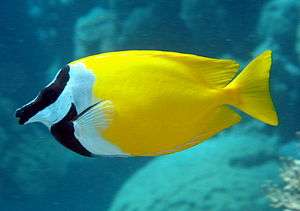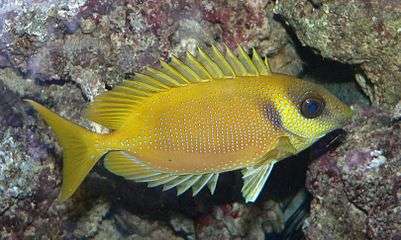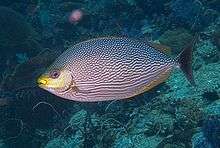Rabbitfish
Rabbitfishes or spinefoots are perciform fishes in the family Siganidae. The 29 species are in a single genus, Siganus.[4] In some now obsolete classifications, the species having prominent face stripes—colloquially called foxfaces–are in the genus Lo. Other species, such as the masked spinefoot (S. puellus), show a reduced form of the stripe pattern. Rabbitfishes are native to shallow waters in the Indo-Pacific,[4] but S. luridus and S. rivulatus have become established in the eastern Mediterranean via Lessepsian migration.[5] They are commercially important food fish,[6] and can be used in the preparation of dishes such as bagoong.
| Rabbitfishes | |
|---|---|
 | |
| A foxface rabbitfish (S. vulpinus) | |
| Scientific classification | |
| Kingdom: | Animalia |
| Phylum: | Chordata |
| Class: | Actinopterygii |
| Order: | Perciformes |
| Family: | Siganidae |
| Genus: | Siganus Forsskål, 1775 |
| Type species | |
| Scarus rivulatus[1] Forskål, 1775 | |
| Species | |
|
About 29, see text | |
| Synonyms[2] | |
| |
Description and ecology
All rabbitfish have large, dark eyes and small, somewhat rabbit-like mouths, which gives them their name. Most species have either bright colors or a complex pattern. The largest rabbitfish grows to about 53 cm (21 in), but most species only reach between 25 and 35 cm (10 and 14 in).[4]
Another unusual feature among rabbitfishes is their pelvic fins, which are formed from two spines, with three soft rays between them. The dorsal fin bears 13 spines with 10 rays behind, while the anal fin has seven spines and nine rays behind; the fin spines are equipped with well-developed venom glands. The sting is very painful, but it is generally not considered medically significant in healthy adults.[6][7]
All rabbitfish are diurnal; some live in schools, while others live more solitary lives among the corals. Rabbitfish sleep in crevices in the reef matrix at night. While sleeping, the rabbitfish Siganus canaliculatus was observed being cleaned by the cleaner shrimp Urocaridella antonbruunii.[8] They are herbivorous, feeding on benthic algae in the wild. However, Siganus rivulatus was recently observed feeding on jellyfish (Scyphozoa) and comb jellies (Ctenophora) in the Red Sea.[9] Also Siganus fuscescens have been observed eating prawns and other baits, suggesting that some species are opportunistic omnivorous feeders. The live passage of benthic organisms in the guts of invasive rabbitfish (ichthyochory) was shown to play a major role in the long distance dispersal and bioinvasion of foraminifera.[10] Rabbitfish are pelagic spawners. Many are fished for food, and the more colorful species—especially the foxfish—are often kept in aquaria.[6] In aquaria, they eat a variety of fresh vegetables and algae.
Taxonomy

In 2007 Kurriwa et al., outlined a way to split the genus—if the scientific community so desires:[11]
- An ancient group containing e.g. S. woodlandi
- Another fairly small group containing, e.g., the S. canaliculatus/S. fuscescens) complex
- The remainder of Siganus, including the foxfaces
Other lineages might exist and make obsolete the somewhat weak distinction between the second and third groups. Also, it is not known where the type species S. rivulatus would fall, hence names for these three subgenera or genera are not established at present.
Hybridizaton has played a role in the evolution of the Siganidae, as evidenced by comparison of mtDNA cytochrome b and nDNA internal transcribed spacer 1 sequence data. Evidence exists of interbreeding between S. guttatus and S. lineatus, as well as between S. doliatus and S. virgatus.[11]
Also, either females of the last common ancestor of S. puellus and the S. punctatus interbred with females ancestral to the main non-foxface lineage, or males of the former hybridized with females of the last common ancestor of S. punctatissimus and the foxfaces, while males of the latter mated with females of the original foxface species.[11]
An individual was found that looked like a slightly aberrant blue-spotted spinefoot (S. corallinus). On investigation, it turned out to be an offspring of a hybrid between a female of that species and a male masked spinefoot, which had successfully backcrossed with the blue-spotted spinefoot.[11]
Species
As noted above, several presumed species are suspected to actively interbreed even today; these might warrant merging as a single species. This applies to the white-spotted spinefoot (S. canaliculatus) and the mottled spinefoot (S. fuscescens), and to the blotched foxface (S. unimaculatus) and the foxface rabbitfish (S. vulpinus). Alternatively they might be very recently evolved species that have not yet undergone complete lineage sorting, but their biogeography suggests that each group is just color morphs of a single species. On the other hand, the morphologically diverse blue-spotted spinefoot (S. corallinus) might represent more than one species; orange individuals are found at the north of its range, while yellow ones occur to the south, and these two may be completely parapatric.[11]


.jpg)

There are currently 29 recognized species in this genus:
- Siganus argenteus (Quoy & Gaimard, 1825) (Streamlined spinefoot)
- Siganus canaliculatus (M. Park, 1797) (White-spotted spinefoot)
- Siganus corallinus (Valenciennes, 1835) (Blue-spotted spinefoot)
- Siganus doliatus Guérin-Méneville, 1829 (Barred spinefoot)
- Siganus fuscescens (Houttuyn, 1782) (Mottled spinefoot)
- Siganus guttatus (Bloch, 1787) (Goldlined spinefoot)
- Siganus insomnis Woodland & R. C. Anderson, 2014 (Bronze-lined rabbitfish)[12]
- Siganus javus (Linnaeus, 1766) (Streaked spinefoot)
- Siganus labyrinthodes (Bleeker, 1853) (Labyrinth spinefoot)
- Siganus lineatus (Valenciennes, 1835) (Golden-lined spinefoot)
- Siganus luridus (Rüppell, 1829) (Dusky spinefoot)
- Siganus magnificus (G. H. Burgess, 1977) (Magnificent rabbitfish)
- Siganus niger Woodland, 1990 (Black foxface)
- Siganus puelloides Woodland & Randall, 1979 (Blackeye rabbitfish)
- Siganus puellus (Schlegel, 1852) (Masked spinefoot)
- Siganus punctatissimus Fowler & B. A. Bean, 1929 (Peppered spinefoot)
- Siganus punctatus (Schneider & Forster, 1801) (Goldspotted spinefoot)
- Siganus randalli Woodland, 1990 (Variegated spinefoot)
- Siganus rivulatus Forsskål, 1775 (Marbled spinefoot)
- Siganus spinus (Linnaeus, 1758) (Little spinefoot)
- Siganus stellatus (Forsskål, 1775) (Brown-spotted spinefoot)
- Siganus sutor (Valenciennes, 1835) (Shoemaker spinefoot)
- Siganus trispilos Woodland & G. R. Allen, 1977 (Threeblotched rabbitfish)
- Siganus unimaculatus (Evermann & Seale, 1907) (Blotched foxface)
- Siganus uspi Gawel & Woodland, 1974 (Bicolored foxface)
- Siganus vermiculatus (Valenciennes, 1835) (Vermiculated spinefoot)
- Siganus virgatus (Valenciennes, 1835) (Barhead spinefoot)
- Siganus vulpinus (Schlegel & J. P. Müller, 1845) (Foxface)
- Siganus woodlandi Randall & Kulbicki, 2005
Footnotes
- Gill, Theodore (1884). "Synopsis of the genera of the superfamily Teuthidoidea (families Teuthididæ and Siganidæ)". Proceedings of the United States National Museum. 7 (18): 280.
- Kottelat, Maurice (2013). The Fishes of the Inland Waters of Southeast Asia: A Catalogue and Core Bibliography of the Fishes Known to Occur in Freshwaters, Mangroves and Estuaries (PDF). The Raffles Bulletin of Zoology, Supplement. 27. Singapore: National University of Singapore. pp. 439–440. ISBN 978-2-8399-1344-7.
- {{cite journal |page=71–73 |last=Seale |first=Alvin |volume=4 |issue=1 |title=Fishes of the South Sea |journal=Occasional Papers of the Bernice Pauahi Bishop Museum of Polynesian Ethnology and Natural History|date=1906 |url=https://www.biodiversitylibrary.org/page/7123048
- Froese, Rainer and Pauly, Daniel, eds. (2018). Species of Siganus in FishBase. August 2018 version.
- Debelius, H. (1997). Mediterranean and Atlantic Fish Guide. ISBN 978-3925919541
- Lieske, E., and Myers, R. (1999). Coral Reef Fishes. 2nd edition. Princeton University Press. Pp. 129–130. ISBN 0-691-00481-1
- Taylor (2000)
- A.R. Bos & C.J.H.M. Fransen (2018). "Nocturnal cleaning of sleeping rabbitfish, Siganus canaliculatus, by the cleaner shrimp Urocaridella antonbruunii (Decapoda: Palaemonidae)". Crustaceana. 91 (2): 239–241. doi:10.1163/15685403-00003753.
- Bos A.R., Cruz-Rivera E. and Sanad A.M. (2016). "Herbivorous fishes Siganus rivulatus (Siganidae) and Zebrasoma desjardinii (Acanthuridae) feed on Ctenophora and Scyphozoa in the Red Sea". Marine Biodiversity. 47 (1): 243–246. doi:10.1007/s12526-016-0454-9.
- Guy-Haim, Tamar; Hyams-Kaphzan, Orit; Yeruham, Erez; Almogi-Labin, Ahuva; Carlton, James T. (2017-06-01). "A novel marine bioinvasion vector: Ichthyochory, live passage through fish". Limnology and Oceanography Letters. 2 (3): 81–90. doi:10.1002/lol2.10039. ISSN 2378-2242.
- Kuriiwa et al. (2007)
- Woodland, D.J. & Anderson, R.C. (2014): Description of a new species of rabbitfish (Perciformes: Siganidae) from southern India, Sri Lanka and the Maldives. Zootaxa, 3811 (1): 129–136.
References
- FishBase (2004): Family Siganidae - Rabbitfishes. Version of 2004-NOV-22. Retrieved 2008-AUG-31.
- FishBase (2006): Siganus species. Version of 2006-MAR-14. Retrieved 2008-AUG-31.
- Kuriiwa, Kaoru; Hanzawa, Naoto; Yoshino, Tetsuo; Kimura, Seishi & Nishida, Mutsumi (2007): Phylogenetic relationships and natural hybridization in rabbitfishes (Teleostei: Siganidae) inferred from mitochondrial and nuclear DNA analyses. Mol. Phylogenet. Evol. 45(1): 69–80. doi:10.1016/j.ympev.2007.04.018 (HTML abstract)
- Taylor, G. (2000): Toxic fish spine injury: Lessons from 11 years experience. J. South Pac. Underwater Med. Soc. 30(1). PDF fulltext